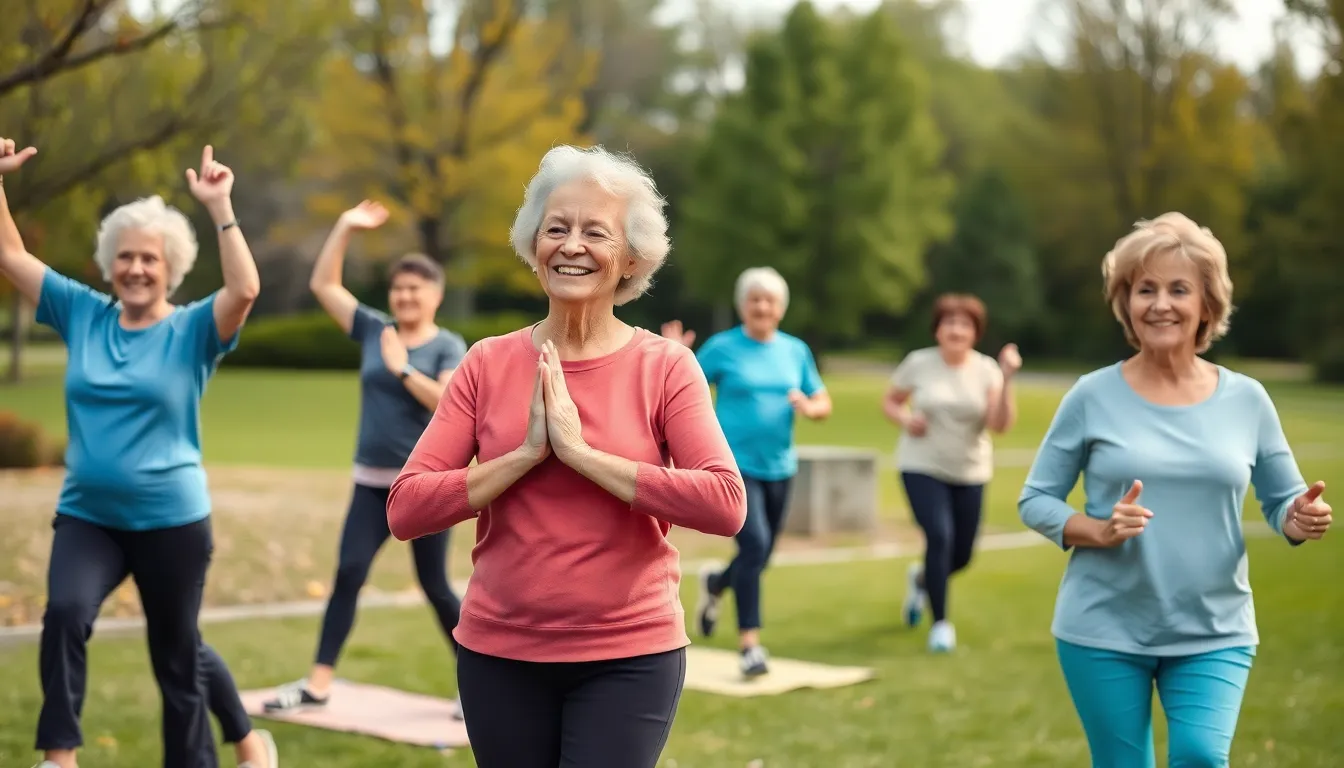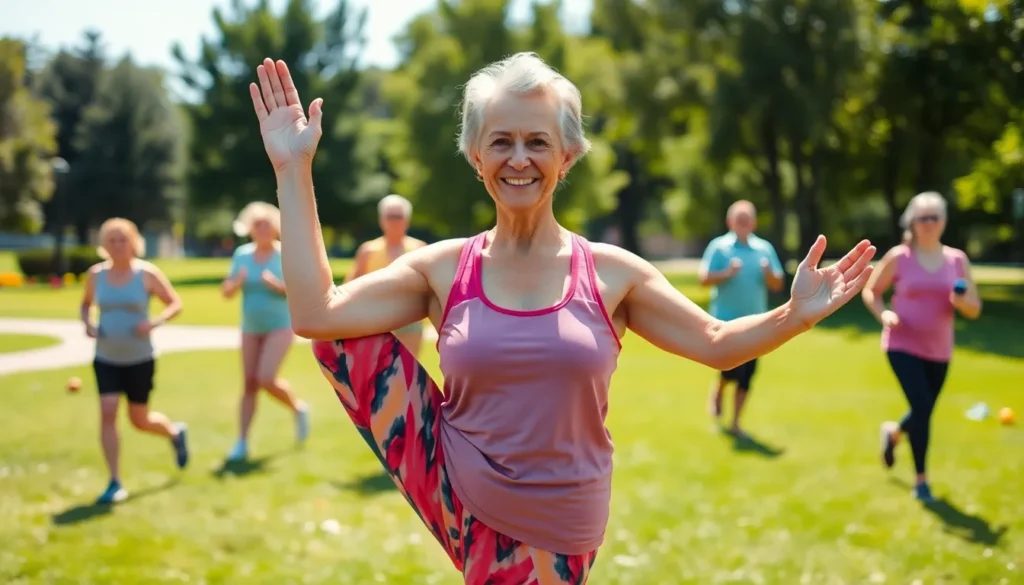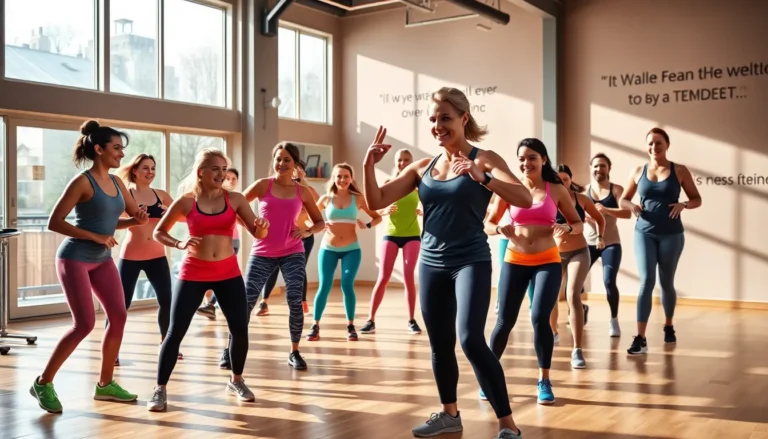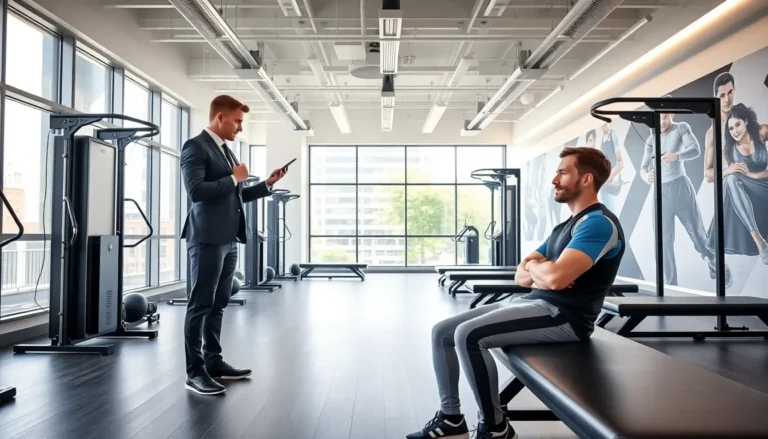Getting older doesn’t mean giving up on fitness; in fact, it’s the perfect time to embrace it! Picture this: seniors strutting their stuff in yoga classes, lifting weights like superheroes, and outpacing their grandkids in the park. Fitness for seniors isn’t just about stretching and taking leisurely strolls; it’s about building strength, boosting energy, and having a blast while doing it.
Table of Contents
ToggleOverview of Fitness for Seniors
Fitness for seniors plays a crucial role in maintaining overall health and wellness. Engaging in regular physical activity enhances mobility, boosts mood, and reduces the risk of chronic diseases. Many seniors practice strength training, which builds muscle mass and improves bone density.
Cardiovascular exercises, such as walking or swimming, elevate heart health and promote endurance. Flexibility exercises, including yoga and stretching, enhance joint mobility and prevent injuries. A balanced fitness routine combines these activities, offering both physical and mental benefits.
Statistics show that nearly 60 percent of seniors benefit from participating in group fitness classes. Social interactions within these groups foster community and motivation, making exercise enjoyable. Additionally, tailored exercise programs address the specific needs of seniors, accommodating for age-related conditions like arthritis or osteoporosis.
Staying active can significantly impact quality of life. Research indicates that regular exercise may delay the onset of disabilities and cognitive decline. Seniors who engage in consistent physical activity report higher energy levels and improved sleep quality.
Access to fitness resources continues to grow, with online classes and senior-specific workout programs becoming widely available. Local community centers and gyms often provide options designed for older adults, ensuring accessibility for everyone. By prioritizing fitness, seniors can embrace an active lifestyle that enhances both physical and mental well-being.
Importance of Physical Activity

Engaging in regular physical activity holds immense value for seniors. It significantly improves health and overall quality of life.
Health Benefits
Regular physical activity lowers the risk of chronic diseases. Heart disease, diabetes, and hypertension statistics highlight this trend. Many seniors enjoy strength training, which enhances muscle mass and bone density. Engaging in cardiovascular activities, like brisk walking or swimming, promotes heart health. Research shows seniors who participate in fitness programs experience improved mobility and reduced falls. Incorporating flexibility exercises can prevent injuries and boost joint health. The positive impacts of exercise extend to fostering independence and prolonging active living.
Mental Well-Being
Exercise enhances mental well-being for seniors. Research indicates that physical activity boosts mood and reduces feelings of depression. Many studies reveal that seniors who stay active report higher energy levels. Engaging in fitness fosters social connections, especially in group classes. These interactions help combat feelings of loneliness and isolation. Improved sleep quality is another benefit directly linked to regular exercise. Practicing yoga or tai chi not only promotes relaxation but also sharpens focus, contributing to better cognitive function. Prioritizing physical activity greatly enriches mental health and promotes a fulfilling lifestyle.
Types of Exercises for Seniors
Seniors can engage in diverse exercises tailored to their needs. Consider the following types:
Strength Training
Strength training enhances muscle mass and bone density. Many seniors benefit from using light weights or resistance bands in their routines. Sessions can be short, focusing on major muscle groups to improve overall strength. Incorporating exercises like squats, modified push-ups, and seated rows proves effective. Consistency matters; conducting strength exercises two to three times per week maximizes benefits. Groups often find motivation together, making the experience enjoyable.
Flexibility Exercises
Flexibility exercises enhance joint mobility and prevent injuries. Seniors can include activities such as yoga, Tai Chi, or simple stretching routines. Holding each stretch for 15 to 30 seconds can significantly improve flexibility over time. Practicing regularly also promotes relaxation and reduces muscle tension. Balancing flexibility with strength training creates a well-rounded fitness program. Group classes provide additional encouragement, fostering social connections while improving health.
Cardiovascular Activities
Cardiovascular activities support heart health and boost endurance. Walking, swimming, and cycling serve as excellent options for seniors, promoting cardiovascular fitness and stamina. Even brisk walking for 150 minutes each week substantially benefits overall health. Participating in group fitness classes creates a supportive environment, enhancing motivation. Engaging in these activities consistently encourages greater energy levels and improved mood. Adopting a mix of cardiovascular exercises ensures a comprehensive approach to fitness for seniors.
Safety Considerations
Safety plays a crucial role in senior fitness. Proper precautions ensure a safe and effective exercise routine.
Consulting with Healthcare Providers
Consultation with healthcare providers is essential before starting any exercise program. Doctors can assess individual health conditions and provide tailored recommendations. They may suggest specific activities to avoid or adapt based on existing medical conditions. Regular check-ins help track progress and adjust plans as needed. Collaborating with physical therapists can also provide personalized guidance and help seniors engage safely in fitness activities.
Avoiding Injuries
Injury prevention is vital for maintaining fitness among seniors. Warm-ups and cool-downs should precede and follow each exercise session. Choosing appropriate workout gear enhances safety and comfort. Low-impact activities minimize strain on joints while still providing cardiovascular benefits. Engaging in exercises designed to improve balance can significantly reduce fall risks. It is advisable to listen to one’s body and take breaks during workouts as needed, allowing time to adjust intensity or modify movements.
Tips for Staying Motivated
Seniors can enhance their fitness journey by setting achievable goals. Specific and measurable objectives create a sense of direction, promoting regular engagement in physical activities. Finding a workout buddy adds an element of social interaction, enhancing accountability and enjoyment.
Joining group fitness classes provides both motivation and community support, with nearly 60 percent of seniors benefiting from such environments. Creating a routine that prioritizes consistency, such as scheduling workouts on specific days, encourages adherence to fitness plans.
Embracing variety keeps routines fresh and exciting. Exploring different types of exercises, from swimming to yoga, prevents boredom and engages multiple muscle groups simultaneously. Listening to one’s body also plays an essential role; rest days are crucial for recovery and overall well-being.
Celebrating small achievements fosters a positive mindset. Recognizing progress, whether it’s improved endurance or enhanced flexibility, boosts morale and encourages continued effort. Incorporating fun elements, like music or outdoor activities, makes workouts feel less like chores and more like enjoyable experiences.
Staying informed about fitness and health can inspire motivation. Reading articles or attending workshops on senior health enhances awareness of the benefits of regular exercise. Lastly, creating a positive environment at home, such as designating a cozy workout space, strengthens commitment to an active lifestyle.
Utilizing online resources and senior-specific programs further supports engagement in fitness. Access to diverse classes and instructional videos expands options, making it easier for seniors to maintain their fitness routines.
Embracing fitness in later years opens doors to a healthier and more fulfilling life. Seniors can experience enhanced mobility increased energy and improved mental well-being through regular physical activity. The variety of exercises available allows for tailored routines that meet individual needs while fostering a sense of community.
Engaging in fitness not only combats the effects of aging but also promotes independence and reduces the risk of chronic diseases. With the right resources and support seniors can enjoy the journey of staying active. By prioritizing fitness they can continue to thrive and enjoy life to the fullest.








